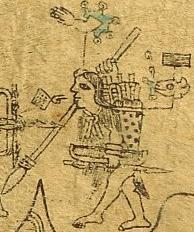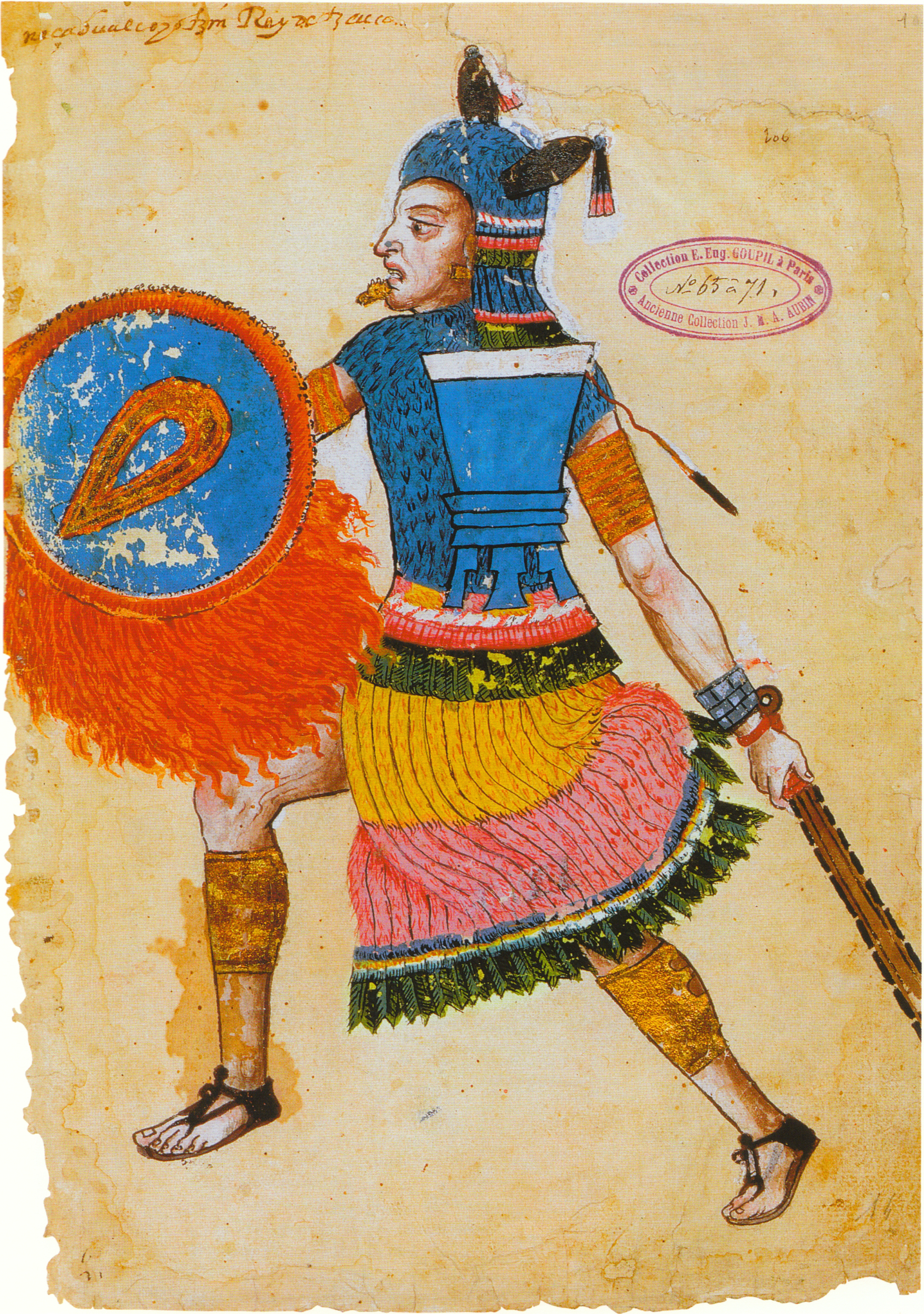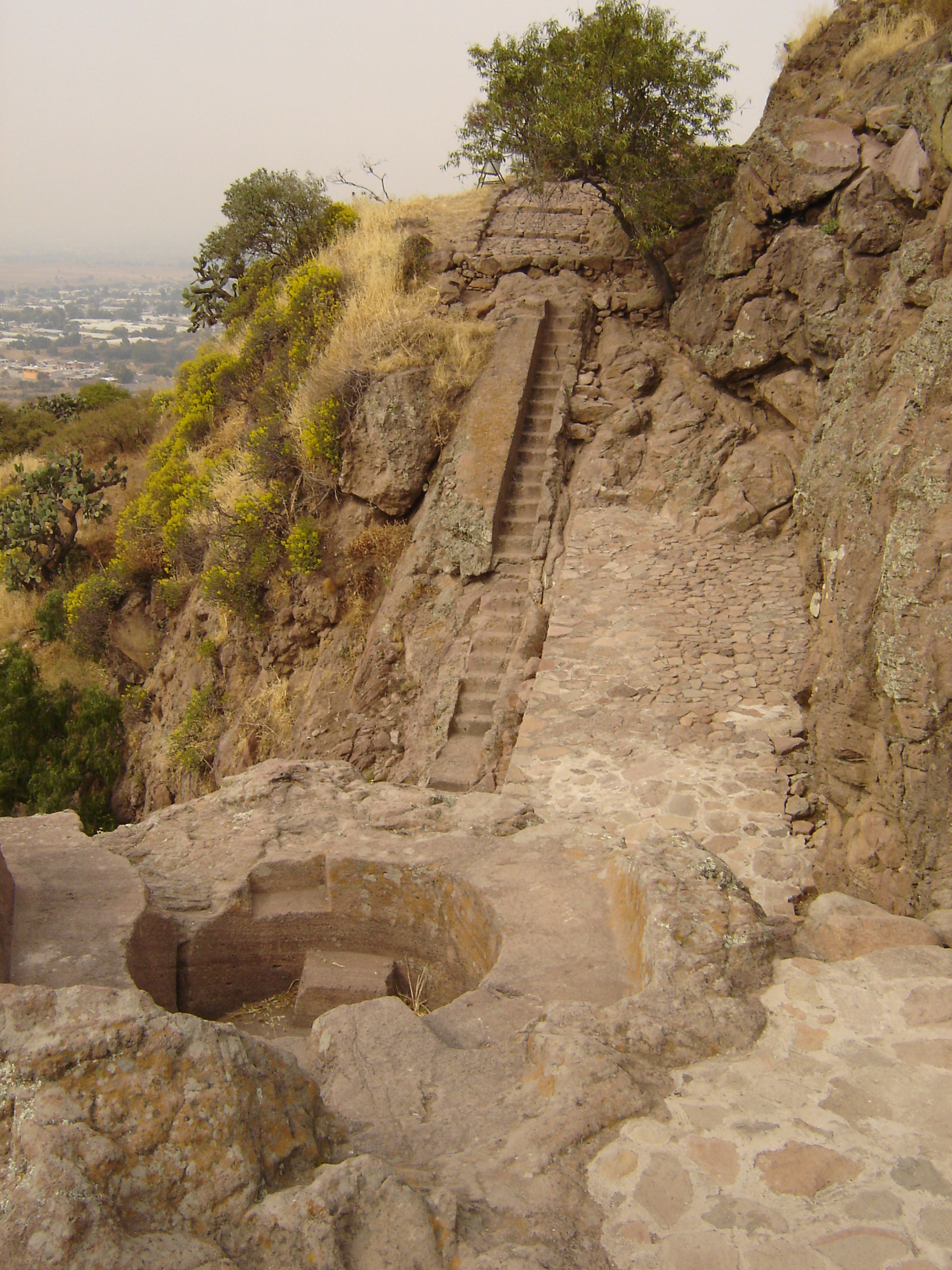|
Nezahualpilli
Nezahualpilli (Nahuatl for "fasting prince"; 1464–1515, ) was king (''tlatoani'') of the Mesoamerican city-state of Texcoco, elected by the city's nobility after the death of his father, Nezahualcoyotl, in 1472. Nezahuapilli's mother was Azcalxochitzin, who married Nezahualcoyotl after the death of her first husband, King Cuahcuauhtzin of Tepechpan. Like his father, he was a poet, was considered a sage, and had the reputation of being a fair ruler. Only one of his poems survives: "''Icuic Nezahualpilli yc tlamato huexotzinco''" ("Song of Nezahualpilli during the war with Huexotzinco"). His court was a haven for astronomers, engineers, and soothsayers. During his reign, he abolished capital punishment for a number of crimes and struggled to keep the political independence of Texcoco during the increasing centralization of Aztec power in Tenochtitlán. When he told Moctezuma II that the Texcocan wise men had foretold foreign dominion over the Valley of Mexico, the emperor chall ... [...More Info...] [...Related Items...] OR: [Wikipedia] [Google] [Baidu] |
Moctezuma II
Moctezuma Xocoyotzin ( – 29 June 1520; oteːkˈsoːmaḁ ʃoːkoˈjoːt͡sĩn̥), nci-IPA, Motēuczōmah Xōcoyōtzin, moteːkʷˈsoːma ʃoːkoˈjoːtsin variant spellings include Motewksomah, Motecuhzomatzin, Montezuma, Moteuczoma, Motecuhzoma, Motēuczōmah, Muteczuma, and referred to retroactively in European sources as Moctezuma II, was the ninth Emperor of the Aztec Empire (also known as Mexica Empire), reigning from 1502 or 1503 to 1520. Through his marriage with queen Tlapalizquixochtzin of Ecatepec, one of his two wives, he was also king consort of that ''altepetl''. The first contact between the indigenous civilizations of Mesoamerica and Europeans took place during his reign, and he was killed during the initial stages of the Spanish conquest of the Aztec Empire, when conquistador Hernán Cortés and his men fought to take over the Aztec capital Tenochtitlan. During his reign, the Aztec Empire reached its greatest size. Through warfare, Moctezuma expanded the ter ... [...More Info...] [...Related Items...] OR: [Wikipedia] [Google] [Baidu] |
Tlatoque Of Texcoco
This is a list of Mesoamerican rulers of the ''altepetl'' of Tetzcoco from the time the city began being ruled by ''tlatoque'' in 1298 to the end of the line of indigenous rulers. From the early 15th century to 1521, Tetzcoco was one of the three leading members of the Triple Alliance, commonly known as the Aztec Empire, but was often subservient to the rulers of Tenochtitlan. The Aztec Empire was conquered by Spain in 1521, but the Spanish colonial authorities continued to appoint ''tlatoque'' of Tetzcoco until the office was abolished in 1564. Pre-colonial rulers (1298–1521) Early Tetzcoco (1298–1431) The ''tlatoque'' of Tetzcoco were descendants and successors of earlier ''tlatoque'' of the Chichimeca, succeeding Xolotl (1172–1232), Nopaltzin (1232–1263) and Tlotzin (1263–1298). In the Triple Alliance (1431–1521) Colonial period (1521–1564) The line of ''tlatoque'' continued in Tetzococo after the Spanish conquest. Adept at navigating the new Span ... [...More Info...] [...Related Items...] OR: [Wikipedia] [Google] [Baidu] |
Tlatoani Of Texcoco
This is a list of Mesoamerican rulers of the ''altepetl'' of Tetzcoco from the time the city began being ruled by ''tlatoque'' in 1298 to the end of the line of indigenous rulers. From the early 15th century to 1521, Tetzcoco was one of the three leading members of the Triple Alliance, commonly known as the Aztec Empire, but was often subservient to the rulers of Tenochtitlan. The Aztec Empire was conquered by Spain in 1521, but the Spanish colonial authorities continued to appoint ''tlatoque'' of Tetzcoco until the office was abolished in 1564. Pre-colonial rulers (1298–1521) Early Tetzcoco (1298–1431) The ''tlatoque'' of Tetzcoco were descendants and successors of earlier ''tlatoque'' of the Chichimeca, succeeding Xolotl (1172–1232), Nopaltzin (1232–1263) and Tlotzin (1263–1298). In the Triple Alliance (1431–1521) Colonial period (1521–1564) The line of ''tlatoque'' continued in Tetzococo after the Spanish conquest. Adept at navigating the new Span ... [...More Info...] [...Related Items...] OR: [Wikipedia] [Google] [Baidu] |
Nezahualcoyotl (tlatoani)
Nezahualcoyotl ( nci, Nezahualcoyōtl , ) (April 28, 1402 – June 4, 1472) was a scholar, philosopher (tlamatini), warrior, architect, poet and ruler (''tlatoani'') of the city-state of Texcoco in pre-Columbian era Mexico. Unlike other high-profile Mexican figures from the century preceding Spanish conquest of the Aztec Empire, Nezahualcoyotl was not fully Mexica; his father's people were the Acolhua, another Nahuan people settled in the eastern part of the Valley of Mexico, on the coast of Lake Texcoco. His mother, however, was the sister of Chimalpopoca, the Mexica king of Tenochtitlan. He is best remembered for his poetry, but according to accounts by his descendants and biographers, Fernando de Alva Cortés Ixtlilxóchitl and Juan Bautista Pomar, he had an experience of an "Unknown, Unknowable Lord of Everywhere" to whom he built an entirely empty temple in which no blood sacrifices of any kind were allowed — not even those of animals. However, he allowed human sacrifices ... [...More Info...] [...Related Items...] OR: [Wikipedia] [Google] [Baidu] |
Cacamatzin
Cacamatzin (or Cacama) (1483–1520) was the tlatoani (ruler) of Texcoco,Diaz, B., 1963, The Conquest of New Spain, London: Penguin Books, the second most important city of the Aztec Empire. Cacamatzin was a son of the previous king Nezahualpilli by one of his mistresses. Traditionally, the Texcocan kings were elected by the nobility from the most able of the royal family. Cacamatzin's election to the throne in 1515 was said to have been made under considerable pressure from Moctezuma II, lord of Tenochtitlán. Moctezuma II wished to lessen Texcoco's power in favor of greater centralization in Tenochtitlán. Cacamatzin wrote ''Cacamatzin Icuic'' ("Song of Cacamatzin"), invoking his father and grandfather; he seems to protest against Pedro de Alvarado's attack during the festival of Tóxcatl. Moctezuma II, under orders from Cortés, had Cacamatzin arrested "in his own palace while discussing war-preparations". The ''Caciques'' of Coyoacan, Iztapalapa, and Tacuba were also ... [...More Info...] [...Related Items...] OR: [Wikipedia] [Google] [Baidu] |
Texcoco (altepetl)
Tetzcoco (Classical Nahuatl: ''Tetzco(h)co'' ) was a major Acolhua altepetl (city-state) in the central Mexican plateau region of Mesoamerica during the Late Postclassic period of pre-Columbian Mesoamerican chronology. It was situated on the eastern bank of Lake Texcoco in the Valley of Mexico, to the northeast of the Aztec capital, Tenochtitlan. The site of pre-Columbian Tetzcoco is now subsumed by the modern Mexican ''municipio'' of Texcoco and its major settlement, the city formally known as Texcoco de Mora. It also lies within the greater metropolitan area of Mexico City. Pre-Columbian Tetzcoco is most noted for its membership in the Aztec Triple Alliance. At the time of the Spanish conquest of the Aztec Empire, it was one of the largest and most prestigious cities in central Mexico, second only to the Aztec capital, Tenochtitlan. A survey of Mesoamerican cities estimated that pre-conquest Tetzcoco had a population of 24,000+ and occupied an area of 450 hectares. The ... [...More Info...] [...Related Items...] OR: [Wikipedia] [Google] [Baidu] |
1515 Deaths
__NOTOC__ Year 1515 ( MDXV) was a common year starting on Monday (link will display the full calendar) of the Julian calendar. Events January–June * January 25 – Francis I of France is crowned (reigns until 1547). * May 13 – Mary Tudor, Queen of France, and Charles Brandon, 1st Duke of Suffolk, are officially married at Greenwich (near London). * June 13 – Battle of Turnadag: The army of Ottoman sultan Selim I defeats the beylik of Dulkadir under Bozkurt of Dulkadir. July–December * July 2 – Manchester Grammar School is endowed by Hugh Oldham, the first free grammar school in England. * July 22 – At the First Congress of Vienna, a double wedding takes place to cement agreements. Louis, only son of King Vladislaus II of Hungary, marries Mary of Austria, granddaughter of Maximilian I, Holy Roman Emperor; and Mary's brother, Archduke Ferdinand, marries Vladislaus' daughter, Anna. * August 25 – Conquistador Diego Velázque ... [...More Info...] [...Related Items...] OR: [Wikipedia] [Google] [Baidu] |
1464 Births
Year 1464 ( MCDLXIV) was a leap year starting on Sunday (link will display the full calendar) of the Julian calendar. It is one of eight years (CE) to contain each Roman numeral once (1000(M)+(-100(C)+500(D))+50(L)+10(X)+(-1(I)+5(V)) = 1464). Events January–December * April 25 – Battle of Hedgeley Moor in England: Yorkist forces under John Neville defeat the Lancastrians under Sir Ralph Percy, who is killed. * May 1 – Edward IV of England secretly marries Elizabeth Woodville, and keeps the marriage a secret for five months afterwards. * May 15 – Battle of Hexham: Neville defeats another Lancastrian army, this one led by King Henry and Queen Margaret themselves. This marks the end of organized Lancastrian resistance for several years. * June 11 – A 15-year-truce between the kingdoms of England and Scotland is signed. * June 18 – Pope Pius II himself shoulders the cross of the Crusades, and departs for Ancona to participate in person. He names ... [...More Info...] [...Related Items...] OR: [Wikipedia] [Google] [Baidu] |
Codex Ixtlilxochitl
Aztec codices ( nah, Mēxihcatl āmoxtli , sing. ''codex'') are Mesoamerican manuscripts made by the pre-Columbian Aztec, and their Nahuatl-speaking descendants during the colonial period in Mexico. History Before the start of the Spanish colonization of the Americas, the Mexica and their neighbors in and around the Valley of Mexico relied on painted books and records to document many aspects of their lives. Painted manuscripts contained information about their history, science, land tenure, tribute, and sacred rituals. According to the testimony of Bernal Díaz del Castillo, Moctezuma had a library full of such books, known as ''amatl'', or ''amoxtli,'' kept by a ''calpixqui'' or nobleman in his palace, some of them dealing with tribute. After the conquest of Tenochtitlan, indigenous nations continued to produce painted manuscripts, and the Spaniards came to accept and rely on them as valid and potentially important records. The native tradition of pictorial document ... [...More Info...] [...Related Items...] OR: [Wikipedia] [Google] [Baidu] |
Valley Of Mexico
The Valley of Mexico ( es, Valle de México) is a highlands plateau in central Mexico roughly coterminous with present-day Mexico City and the eastern half of the State of Mexico. Surrounded by mountains and volcanoes, the Valley of Mexico was a centre for several pre-Columbian civilizations, including Teotihuacan, the Toltec, and the Aztec. The ancient Aztec term ('Land Between the Waters') and the phrase Basin of Mexico are both used at times to refer to the Valley of Mexico. The Basin of Mexico became a well known site that epitomized the scene of early Classic Mesoamerican cultural development as well. The Valley of Mexico is located in the Trans-Mexican Volcanic Belt. The valley contains most of the Greater Mexico City, Mexico City Metropolitan Area, as well as parts of the State of Mexico, Hidalgo (state), Hidalgo, Tlaxcala, and Puebla. The Basin of Mexico covers approximately in the NNE-SSW direction with length to width dimensions of approximately to The Valley of ... [...More Info...] [...Related Items...] OR: [Wikipedia] [Google] [Baidu] |
Tlatoque
''Tlatoani'' ( , "one who speaks, ruler"; plural ' or tlatoque) is the Classical Nahuatl term for the ruler of an , a pre-Hispanic state. It is the noun form of the verb "tlahtoa" meaning "speak, command, rule". As a result, it has been variously translated in English as "king", "ruler", or "speaker" in the political sense. Above a tlahtoani is the ''Weyi Tlahtoani,'' sometimes translated as "Great Speaker", though more usually as "Emperor" (the term is often seen as the equivalent to the European "great king"). A ' () is a female ruler, or queen regnant. The term refers to "vice-leader". The leaders of the Mexica prior to their settlement are sometimes referred to as , as well as colonial rulers who were not descended from the ruling dynasty. The ruler's lands were called , and the ruler's house was called ''Nahuatl dictionary'' (1997). Wired humanities project. Retrieved January 1, 2012, frolink/ref> The city-states of the Aztec Empire each had their own tlatoani, or lea ... [...More Info...] [...Related Items...] OR: [Wikipedia] [Google] [Baidu] |
Akademische Druck- Und Verlagsanstalt
:''There also were unrelated publishing houses in Stuttgart and in (East-)Berlin, and there is the (JAVG).'' The Akademische Druck- und Verlagsanstalt (ADEVA) is an Austrian book publisher in Graz that specialises primarily in publishing lavish facsimile editions. History The publishing house was founded by Paul Struzl (1914–1973) in Graz. Trained as a typesetter and with a doctorate in economics, Struzl began work in 1947 by acquiring a Rotaprint machine from the province of Styria and founding an offset printing company under the name of his father-in-law Franz Hacker. In 1949, Struzl founded the Akademische Druck- und Verlagsanstalt and brought in the printing works he had established in 1947.Karlpeter Elis''Steirische Druckgeschichte'' 1982; retrieved 2 July 2021 Numerous library holdings had been destroyed in World War II, therefore the focus of activity was first on reprinting scholarly works, often in collaboration with the Wissenschaftliche Buchgesellschaft. In the ... [...More Info...] [...Related Items...] OR: [Wikipedia] [Google] [Baidu] |







